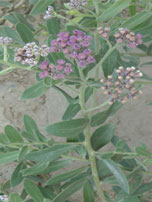SHAHEED
KARTAR
SINGH
SARABHA
A Y U R V E D I C M E D I C A L C O L L E G E & H O S P I T A L
Affiliated to Guru Ravidas Ayurved University, Hoshiarpur Punjab
Affiliated to Guru Ravidas Ayurved University, Hoshiarpur Punjab

Botanical Name : Pluchea lanceolata
Family : Asteraceae
Names in different Indian languages :
English : Lesser Galangal
Hindi : Kulanajan,
Kannada : doddarasagadda
Malayalam : Aratta,cittaratta, kolinji
Sanskrit : Rasna, sugandhamula
Tamil : Arattai,peraattai
Telugu : Dumparastramu
Unani : Khulanjaan
Synonyms :
Kulanjana, Sthuulagranthi, Sugandhaa, Ugragandhaa,
Malaya Vachaa, Mahaabhari- Vachaa.
Morphology :
1. It is a perennial herb, occurring in Indo-Gangetic plains, 30-60 cm tall.
2. Stem and branches are terete, slender and softly pubescent.
3. Leaves are 2-6 cm in length, sessile, oblanceolate or oblong, coriaceous, finely silky and pubescent on both surfaces, margins entire or obscurely dentate near the apex.
Distribution & Habitat :
Source plant of Rasna in Northern India
Varieties and Adulterants :
Plants used as Raasnaa in Indian medicine: Alpinia galangaWilld. (Zingiberaceae) in southern India; Pluchea lanceolata C. B. Clarke (Compositae; Asteraceae) in Uttar Pradesh; Vanda roxburghii R. Br. (Orchidaceae) in eastern Uttar Pradesh and West Bengal; Blepharispermum subsessile DC. (Compositae; Asteraceae) in Madhya Pradesh; and Dodonaea viscosa (Linn.) Jacq. (Sapindaceae) in AndhraPradesh.
Properties :
Rasa- katu,tikta
Guna- laghu
Virya- ushna
Vipaka- katu
Karma : deepana,pachana, vedana hara, kaph-vatha hara
Srotogamitva :
Dosha : vatha-kapha hara
Dhatu : asthi, maja
Mala :mutrala
Organ : bone, bone marrow
Indication :
Rhizome—carminative (in dyspepsia), stomachic, circulatory stimulant, diaphoretic, anti-inflammatory. Useful in diabetes, asthma,tuberculosis, rheumatoid arthritis, cough, obesity, fever, O.A.
Part used :
Rhizome
Dosage :
Rhizome—2-3 g powder.
Decoction—50-100 ml
Important Yogas or Formations :
Rasna sapthakam, rasna panchkam kashaya
Therapeutic Uses :
Rasna powder + honey useful in gout
Rasna powder in milk useful in osteo-arthritis